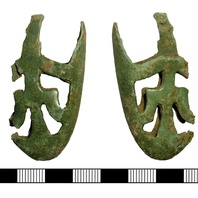
Viking Objects
Scabbard Chape (NLM-5BD697)
The incomplete openwork tongue-shaped front plate of this chape is decorated with at least six asymmetrical apertures and resembles similar chapes with ‘Birka Falcon’ decoration.
Read More
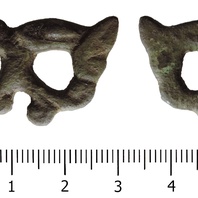
Viking Objects
Zoomorphic Mount (DENO-7E523C)
This example of a copper-alloy openwork zoomorphic mount, strap fitting or harness fitting, is decorated with the head of an animal in profile.
Read More
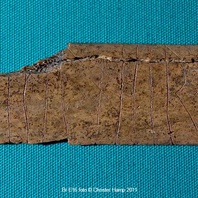
Viking Objects
Rune Inscribed Rib (LCNCC : 1999.103.104)
Runes were used not only for monumental inscriptions, or to mark ownership of valuable objects, but also in more informal contexts. In this case the animal bone suggests an after-dinner pastime after a good meal in the Anglo-Scandinavian trading centre of Lincoln. The runes read ——l × hitir × stin × … Only two words of the Old Norse inscription can be read with certainty, and even so they are ambiguous. One possible interpretation is ‘[someone] is heating a stone’ the other is ‘[someone] is called Stein’. The bone is fragmentary, but the inscription may never have been intended to make much sense. The object dates from around the 10th century. It is one of only three runic inscriptions from the East Midlands.
Read More
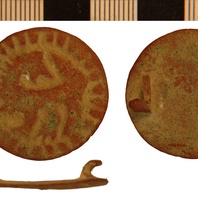
Viking Objects
Brooch with Backwards-Facing Beast (NLM-08BAEB)
It has been suggested that the beast motif on this brooch represents a horse, but identification is uncertain. This brooch was probably the property of an ordinary person rather than of a member of the social elite. It is of a fairly common type. For more information on Scandinavian jewellery in England check out our blog: Brooches, Pendants and Pins: Scandinavian Dress Accessories in England.
Read More

Viking Names
Riby
Riby, in the Yarborough Wapentake of Lincolnshire, was originally an Old English compound Rygetun ‘the farmstead or village where rye grows’. The Old English tun ‘farm, settlement’ was replaced by Old Norse by ‘farm, settlement’.
Read More
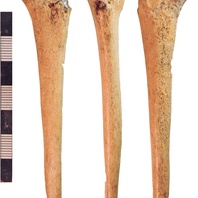
Viking Objects
Pin-Beater (NLM-78D3B5)
This pin-beater was made from a large mammal limb bone, trimmed to a rounded point and smoothed and glossed by wear and handling. Single-ended simple weaving tools are a class linked to the Anglo-Scandinavian use of the vertical loom.
Read More
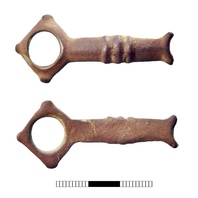
Viking Objects
Harness Fitting (SUR-38C283)
A simple double ended strap-link used as part of a harness. The metal has a reddish tint often associated with Anglo-Scandinavian material.
Read More
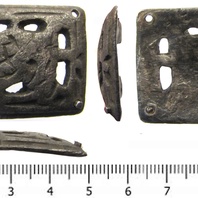
Viking Objects
Anglo-Scandinavian Silver Mount (SWYOR-0201A1)
This silver rectangular mount is decorated with an openwork design consisting of a possible backward-facing animal alongside interlace which may have zoomorphic elements.
Read More
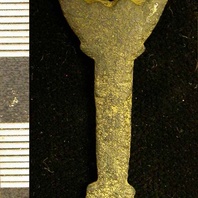
Viking Objects
Copper-Alloy Key (LEIC-931912)
Slide keys such as this example are generally known as ‘Viking keys’ due to similarities in shape with excavated examples. However, its T-shaped projections at the base have no identified parallels but the design could possibly show Anglo-Scandinavian influence. Keys were not only practical items but also symbols of status. Women often carried the keys to the family’s chests of valuables. They also are often buried with keys, representing their authority in the household. See also the blog post on keys in the Viking Age.
Read More
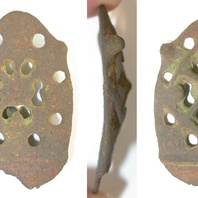
Viking Objects
Copper-Alloy Strap-End (DENO-083C15)
This copper-alloy strap-end, classified as Thomas Class E, is decorated with a central openwork lozenge with two perforations within each quarter surrounded by eight circular perforations. Strap ends came in various styles and were fairly common throughout the Viking world. They were used to decorate the ends of belts and to stop them getting damaged.
Read More
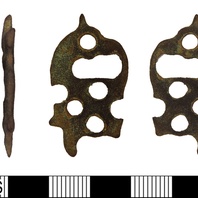
Viking Objects
Urnes-Style Strap-End (LEIC-B46A41)
This fragmentary copper-alloy strap-end is decorated with openwork zoomorphic design in the Urnes style. It has been classified as a Thomas Class G strap-end.
